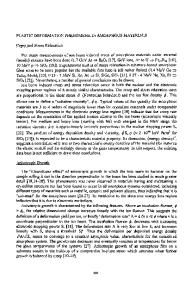The Origin Of The 0.78 eV Luminescence Band In Strained Layer SiGe/Si
- PDF / 693,762 Bytes
- 6 Pages / 612 x 792 pts (letter) Page_size
- 9 Downloads / 224 Views
I5.1.1
The Origin Of The 0.78 eV Luminescence Band In Strained Layer SiGe/Si Anthony J. Kenyon1, Edward A. Steinman2, Christopher W. Pitt1, David E. Hole3, and Vladimir I. Vdovin4 1
Department of Electronic & Electrical Engineering, University College London, Torrington Place, London WC1E 7JE, United Kingdom. 2
Institute of Solid State Physics, Russian Academy of Sciences, Chernogolovka, Moscow District 142432, Russia.
3
Ion Implantation Laboratory, School of Engineering and I.T., University of Sussex, Falmer, Brighton, BN1 9QH, United Kingdom.
4
Institute for Chemical Problems of Microelectronics, B. Tolmachevsky per. 5, 109017 Moscow, Russia. ABSTRACT
The photoluminescence band around 0.78 eV that is sometimes seen in strained layer SiGe samples or deformed silicon containing a high density of dislocations has been attributed to the presence of oxygen complexes. In this study we have prepared a set of Si0.9Ge0.1 samples by MBE which have then been implanted with iron, erbium, or oxygen in order to study the effect of implanted impurities on photoluminescence in the technologically important region around 1.5 microns. Following implantation with oxygen, two luminescence bands appear around 0.85 eV and 0.78 eV, respectively. However, these bands are not present in either the unimplanted sample or those subject to Er or Fe implantation. The correlation between oxygen doping and the appearance of these bands supports the conjecture that they are associated with oxygen complexes. INTRODUCTION Deformation of crystalline silicon due to strain produced by the growth of a layer of Si1-xGex gives rise to luminescence bands in the near infra-red that are associated with dislocations [1,2]. The bands are conventionally labelled D1, D2, D3, and D4, and occur at energies between 1.0 eV and 800 meV dependent on the nature of the sample and its thermal history. Of these luminescence bands, the D1 line, which occurs at energies around 800-820 meV is of particular interest because it coincides with the principal low-loss window in silica optical fibres. The promise of a silicon-based source operating at these energies is very attractive, and for that reason much research has been directed at understanding the source of this luminescence band. It is generally thought that the D1 band arises from misfit dislocations in the silicon host; it is thought to be due to a point defect on a dislocation line that corresponds to the intersection of two dislocations. Such dislocations may readily be produced by compressive strain at elevated
Downloaded from https://www.cambridge.org/core. UNSW Library, on 18 Apr 2020 at 02:31:21, subject to the Cambridge Core terms of use, available at https://www.cambridge.org/core/terms. https://doi.org/10.1557/PROC-770-I5.1
I5.1.2
temperatures, or by the growth of a fully relaxed epilayer of SiGe on a single crystal silicon substrate [1,3]. However, there remains uncertainty over the role of impurities in D-band luminescence, and there have been suggestions that the presence of transition metal i
Data Loading...










